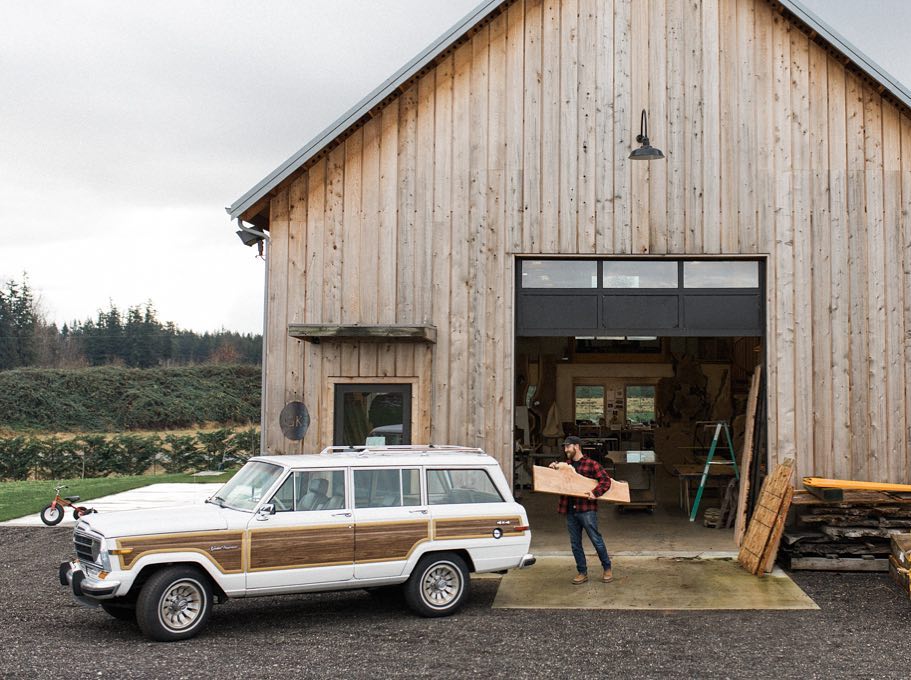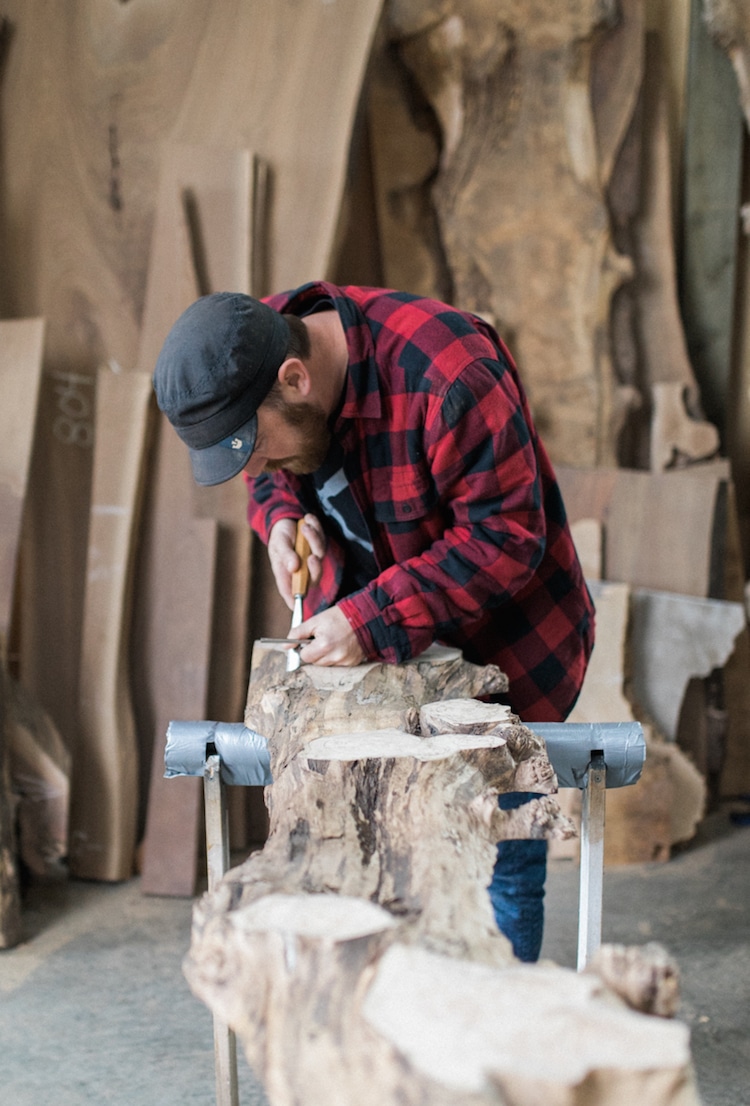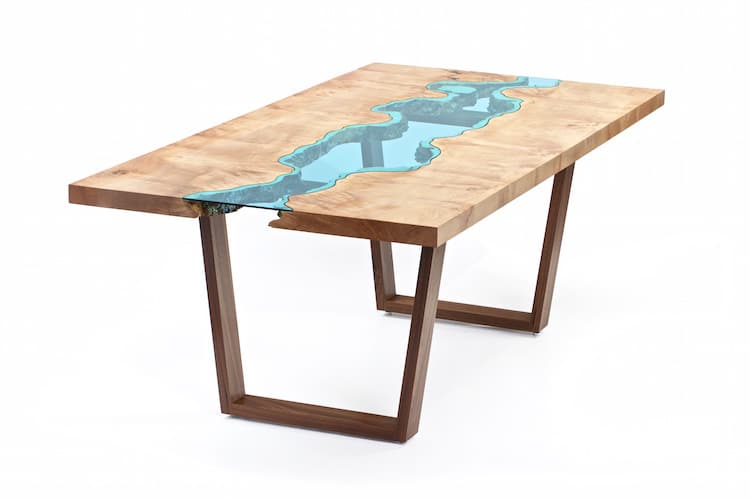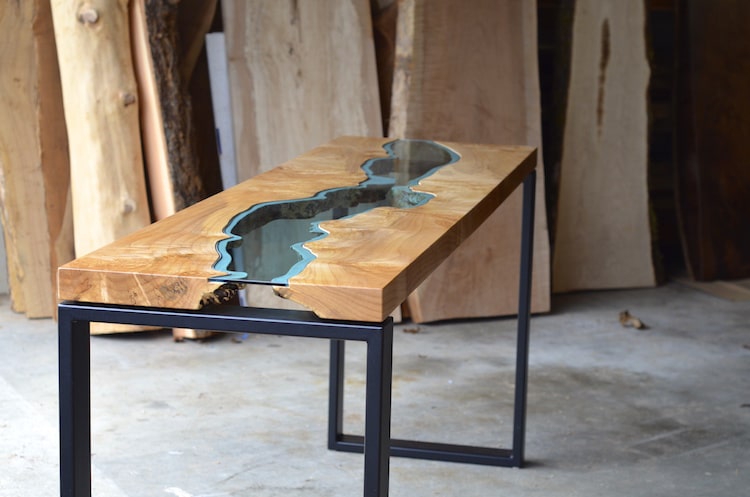
Credit: Greg Klassen
Greg Klassen is the man who originally created the River Table, and subsequently a River Collection. Based in the Pacific Northwest of North America, Greg successfully sends his creations all over the world. The demand is such that he can, at times, have a two-year order backlog for his work. But it wasn’t always this way, as you’ll find out below.
Greg originally started making furniture while he was in college. He took a year out from his education to get a job in order to help his wife finish her education. While working this job at a door-making plant, he would bring home discarded wood pieces to make furniture for their first home. A passion for woodworking was born and Greg later went on to study fine woodworking at the College of the Redwoods (now The Krenov School) in Fort Bragg, CA and at Capellagården School of Craft & Design in Vickleby, Sweden.
During my conversation with Greg, he tells how;
-
His first River Table didn’t sell quickly at first.
-
Even when he struggled financially, he still wasn’t afraid to make expensive mistakes.
-
He engineered his viral success with “creative marketing”.
-
He has challenged himself to work a little less every year while still providing a living for his family.
-
Dance pop is what gets him going in the studio!
Dónal Moloney: Greg, thanks so much for taking the time to do this interview. I normally like to start with a question about how you got started in woodworking, but I know that you’ve answered that question quite a few times over the years. So instead, I’d like to go back to the time you created the first ever River Table. I think it’s fair to say that the River Table has reached iconic status at this stage. It must have been incredibly exciting when you finished the first one. I imagine you in your studio rubbing your hands over the freshly finished piece, and contentedly admiring it. Maybe calling your wife out to the studio to see it. At least that’s what I would have done! Can you describe the feeling you had when you created the first one? What was going through your mind? And had you any idea how coveted and loved your River Tables would prove to be?
Greg Klassen: When I created the first River Table I felt a surge of excitement because I felt I was on to something fresh and original. I was immensely proud of that first table and I began taking it to a few of the arts festivals I was doing at the time. I started to experience something at the art shows that confirmed I had created something special – people were returning to my booth with their friends to come see my table a second time. My work up to that point had always been appreciated, but my new work was now causing an emotional reaction with people and they would exclaim about how much they loved it or describe to me how it made them feel. I’ve had people tell me in great detail how my work makes them smile, or brings back a childhood memory, or brings them a heartfelt tear. Sometimes a craftsman thinks he has a great design or idea, but the true test of its appeal is when you start to hear how others feel about it.
While my work has become a success these past few years, my tables didn’t quickly sell at first. I took my first River Table to 3 or 4 shows before I sold it. Then after that I made more River Tables and took them to more shows — I still had meagre sales. After careful consideration I decided to take a big risk and launch the River Collection (tables and art pieces) at a big design show in NYC. It was a big flop and I didn’t sell anything or take any orders. It was a crushing blow and ate up most of our money, not to mention about 6 months of time creating new work. However, I really believed in my work, so I persisted and after my work went viral in July 2014 my work reached the masses and suddenly brought me the success that I always imagined for my work but had never seen.

The First Ever River Table | Credit: Greg Klassen
DM: Creating a beautifully crafted piece like a River Table is a fantastic achievement in itself. But we all have families to support, and food to put on the table. So, a business element naturally comes into play. How long was it before enough people started to learn about your River Tables, and you were able to provide a living for your family from your River Collection? Did it all begin to happen pretty quickly after the first one? Does this business side of you conflict in any way with your artistic, creative side?
GK: My approach to business as an artist and a craftsman is to have a willingness to be impractical and to follow my creative impulses. When I made the first River Table, it was really expensive to make and I didn’t know if it would work. But I’ve decided to be okay with making expensive mistakes. You don’t know until you try, right? So I’ve always been willing to try and fail. Each failure has helped to shape my artistic voice.
I’ve been able to provide for my family since I opened my studio on June 8, 2008, nearly ten years ago. We lived extremely modestly for the first 6 years; another perhaps more honest way to put it was that we were “dirt poor”. I was a starving artist. I had a small measure of success with my River Tables beginning in 2011 but things didn’t really take off until July 2014 after some creative marketing led to my sudden viral fame. Since then I’ve stayed busy selling my work and taking commissions. I’ve had up to a twenty-four month order backlog at times and recently have intentionally trimmed that down to six months so I can focus on creating new work for my website. I continue to ship my work all over North America and around the world.
“AS A MAN, WHETHER YOU WANT TO OR NOT, YOU PLACE MUCH OF YOUR IDENTITY ON YOUR ABILITY TO PROVIDE FOR YOUR FAMILY. WHEN I WAS STRUGGLING TO PROVIDE, IT REALLY WORE ME DOWN.”
— GREG KLASSEN
DM: I have to say that’s an incredible turnaround — and outstanding persistence on your part. So you were a six-year, overnight success!? It’s probably reasonable to say that most people would probably have given up at some point between June 2008 and July 2014. Did you ever consider packing it in and trying something else? You must have had moments when you were a starving artist that you thought “screw this, I’m going to do something else” — did you? What kept you going, and can you lend any insight into your “creative marketing strategy” that led to your sudden viral fame. What did you do that kickstarted it?
GK: During my years of struggle, I was enjoying my work but I took it pretty hard that my work wasn’t selling. As a man, whether you want to or not, you place much of your identity on your ability to provide for your family. When I was struggling to provide, it really wore me down. I took some side jobs delivering phone books, doing odd jobs for local folks and even applied for a job as a flower delivery guy. I was looking for something that would just be sure money and give us some financial relief. None of those things really helped much and it was pretty discouraging to be so poor for so long. It was tempting to give up, but I never did. I think grit and perseverance are two important keys to being successfully self-employed, and particularly important for people who have chosen a career as impractical as artist or furniture maker. You can’t give up. And you also can’t stop marketing yourself and your work. This was something I worked really hard at. I spent lots of my energy trying to get people to notice my work and find new opportunities to sell it. We traveled around to arts festivals all around the country, even driving from Washington state to Washington, DC for a four-day craft show with the Smithsonian museum. I also educated myself on how to pitch my work to magazines and writers. It was these efforts that led to my going viral when I shared my work with the right outlet. The thing that people need to know is that there is no prescriptive strategy for marketing. You just have to be smart and try everything. I became a student of marketing, I tried everything I could think of and failed at most of them, but eventually a few things worked in my favor.

Credit: Greg Klassen
DM: One of the joys of working with wood is getting to enjoy the process of making. The act of creating something is incredibly satisfying. As woodworkers we often have to remind ourselves to enjoy the process—especially if we have a deadline to meet. What parts of your job do you most enjoy? And do you allow yourself to enjoy the process?
GK: This is an important question. Most professional woodworkers begin as passionate hobbyists until they decide they want to do it professionally. The transition from hobby to profession must be handled with care. What I mean is that it’s easy to go where the money is (or where you think it is). I’ve seen many woodworkers dream of being furniture makers only to start taking better-paying cabinet jobs. Seems like an innocent decision and a great way to pay the bills, but then suddenly they’re buying tools that are designed for making plywood cabinets and after a while the idea of switching to making hand-crafted furniture seems especially risky, so they just don’t. They stick with the easier option, even thought their hearts are not into it. There’s nothing wrong with being a cabinet maker…I just mean to point out that many cabinetmakers initially aspired to make finer things and during that transition into a professional woodworker they listened to the money rather than their hearts. I have always tried to put my passions before profits. Do I enjoy what I’m working on? Am I excited about this design? If the answer is yes, then I keep at it. If that answer is no, then I know I need to change something. I love what I do. I continue to experiment and grow my designs, always trying new things. I especially enjoying the initial discovery/design phase, where the idea is born. And of course I love all of the woodworking, being hands on with beautiful materials.

Credit: Greg Klassen
DM: Following your work on Instagram is a fantastic little snapshot into your life and work. From the outside it seems like you work hard but are yet still able to enjoy time with your family throughout the day—even during what many people would term “normal business hours”. I see that you even have plans to build an amazing treehouse for the kids this year some time. To many woodworkers, this all seems like it would be their perfect work/life scenario. Do you find it hard to keep a balance? Surely like everyone else, you must have your daily challenges in your studio. What are these challenges and how do you manage them?
GK: My oldest child Ruth was born the same year I started my business ten years ago. So I’ve never known business ownership without a child in the family. The first few years I had to work hard to establish some balance and now I have that balance pretty well established. The secret to balance is simple: knowing your priorities. My priorities are simple – it’s faith, family and then my work. Because my family comes before my work, it’s easy for me to not overwork because I’m spending time with family which is much more important to me. Another thing that helps that balance is a personal challenge that I’ve given myself: to make a good living while working a little less every year. I want my kids to grow up knowing that their dad loved them and was always available to them.
“I’VE TURNED DOWN THE OPPORTUNITY TO GROW AND MAKE MORE MONEY TIME AND AGAIN. I’VE TURNED AWAY REALLY PROFITABLE SHORT-TURNAROUND ORDERS SO I COULD SPEND MORE TIME WITH FAMILY. I’VE TURNED DOWN OFFERS FROM PEOPLE WHO HAVE VOLUNTEERED TO WORK FOR ME FOR FREE. I’VE TURNED DOWN OPPORTUNITIES TO BE ON FURNITURE/DESIGN-RELATED REALITY TV SHOWS.”
— GREG KLASSEN
DM: One of the things I find very interesting, is discovering the habits of other woodworkers. I love learning what others do on a daily basis. What are your daily routines? What does a typical day look like in your studio?
GK: I work seven to eight hours, five days a week. I sometimes work a night here or a Saturday there, but I generally try to work Monday to Friday and preserve weekends for family time. However, when I work I try to be very efficient. I often check my email in the morning with a cup of coffee close by. In the morning I make an ambitious to-do list for the day but remain flexible for surprises that come up. I also allow myself to totally scrap my to-do list for the day if I get inspired to create something new. It’s really important for me to chase my inspiration when it comes. What good is a great idea, if you have it and then just stick it on a shelf? Usually you never get around to it, or your passion is diminished when you try to revisit it later. So I like to stop what I’m doing and see where the idea goes. Most of the pieces I sell on my website begin as this kind of impulse.
I end every day by coming home (about a thirty second walk) for dinner at 5pm. I usually share all three meals each day with my family. Being a one-man shop I deal with loneliness a lot of the time, so it’s important for me to spend time with them whenever I can. It helps to keep me from going crazy out there alone in the shop 😉

Credit: Greg Klassen
DM: How do you define success in your life and in your career? Do you consider yourself successful?
GK: I define success as a life well-lived. For me that’s being a faithful husband, father and friend. From a business perspective we often like to define success with how much money you can make and how big you can grow. I’ve turned down the opportunity to grow and make more money time and again. I’ve turned away really profitable short-turnaround orders so I could spend more time with family. I’ve turned down offers from people who have volunteered to work for me for free. I’ve turned down opportunities to be on furniture/design-related reality TV shows. I have a personal mission statement that keeps me grounded and if the opportunities do not agree with it, I say “no thanks”. To answer your question, yes, I consider myself successful. I’m also humble enough to know that things change and that ultimately we are not in control of our lives. I’m thankful for where I am at and am savoring this time I’m at in life where I get to do work I love and spend a lot of time with my family. I feel very blessed.

Credit: Greg Klassen
DM: What advice would you give a young Greg Klassen just starting out on his woodworking career?
GK: Become an expert in your craft. Always experiment. Be original. Put people before profits. Do the work you’re excited about.
DM: Greg, thanks again for your time, I’ve really enjoyed your insights. If it’s okay with you I’d like to finish with a quick-fire round.
QUICK FIRE:
DM: What tool purchase turned out to be your best investment?
GK: All of my Festool tools – the sanders, dust extractors, track saws and jigsaw.
DM: What do you see other woodworkers do that annoys you?
GK: Imitate my work without giving me credit for my design.
DM: What’s your favourite song to blast in studio?
GK: I listen to many different types of music, but my “dance pop” station on Pandora gives me a real productivity boost at about 3pm in the afternoon! 😉
DM: What are you not very good at?
GK: Sweeping up my shop and putting away tools.
DM: What have you got on the bench at the moment?
GK: Two art pieces for my upcoming Archipelago Series, a pair of River wall-hangings, a dining table, and drawings for our family’s treehouse.
DM: Who’s your favourite woodworker/creator/artist, past or present?
GK: Sam Maloof – incredible furniture maker/artist and an even better person.
THANKS
I’d like to thank Greg for taking the time to answer my questions. His story is hugely inspiring and positive. Any woodworker who has ever been self-employed will certainly be able to relate to Greg’s experiences. Greg held his nerve, and stayed the course of his woodworking career, displaying grit and perseverance, when it may have been easier to do something else.
While his story is amazing, his work is just as wonderful. I love the thought of him in his shop, scrapping his to-do list for the day when he gets the urge to create something new. What a great way to work! He constantly turns out beautiful pieces that are so carefully thought out and so well designed. Greg’s work and story should be an inspiration for all woodworkers.
While it’s important to be inspired by Greg and by other great woodworkers — we shouldn’t take it literally. We all have our own unique situations, so doing what worked for Greg won’t necessarily work for you or I. The lesson is to try things and see what works for you. Similarly, I see little point in copying his work (giving credit or not).
They say imitation is the sincerest form of flattery, and the River Table is one of the most copied pieces you’re likely to see at the moment. If you want to build a River Table, that’s fine, but you’re probably doing yourself a disservice. Think how much more fulfilling it would be to create something new and unique — a design of your own. Nothing is ever completely unique, we take inspiration and elements from the work of past masters, but what I mean is to explore your own creativity rather than directly copy something. You never know where it might lead you. It could be to success and fulfilment just like Greg Klassen.
To find out more about Greg’s work visit:
www.gregklassen.com
https://www.instagram.com/gregklassenfurniture/
P.S. If you liked this article, you may also like to get free and practical tips on woodworking techniques, business growth, productivity, and more in your inbox each week (you’ll also get the “How to Make a Living From Woodworking” PDF guide). Simply SIGN UP HERE to get exclusive access to a wealth of knowledge.
This post appeared first on https://www.sawdustetc.com